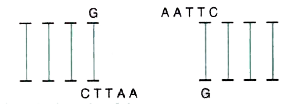Restricito enzymes cut the strand of DNA a little away from the centre of the palindromic site, but between the same two bases on the opposite single stranded strand, these overhanging stretches formed on each strand are called __________
Blunt ends
Stickly ends
Staggered end
Both (2) & (3)
The correct Answer is:D
To solve the question regarding the type of overhanging stretches formed on each strand of DNA after being cut by restriction enzymes, we can follow these steps:
1. Understand the Role of Restriction Enzymes:
- Restriction enzymes are proteins that cut DNA at specific sequences known as restriction sites. These sites are often palindromic, meaning the sequence reads the same forwards and backwards on complementary strands.
2. Identify the Palindromic Sequence:
- For example, consider a palindromic sequence like:
- 5' - G A A T T C - 3'
- 3' - C T T A A G - 5'
- Here, the restriction enzyme will cut between specific bases in this sequence.
3. Determine the Cut Location:
- In the example given, the restriction enzyme EcoRI cuts between the bases G and A on one strand and between the same two bases on the opposite strand. This results in overhanging ends.
4. Define the Overhanging Stretches:
- The overhanging stretches formed after the cut are not even; instead, they are uneven because the cut does not occur at the same position on both strands.
5. Classify the Ends:
- The uneven ends created by the restriction enzyme are referred to as "sticky ends." These sticky ends can easily pair with complementary sequences of DNA, facilitating the ligation process in genetic engineering.
6. Evaluate the Options:
- Given the options:
- a) Blunt end
- b) Sticky end
- c) Tight end
- d) Both second and third
- Based on the understanding of the cuts made by restriction enzymes, the correct answer is "sticky end."
Final Answer:
The overhanging stretches formed on each strand are called sticky ends.
---
- Restriction enzymes are proteins that cut DNA at specific sequences known as restriction sites. These sites are often palindromic, meaning the sequence reads the same forwards and backwards on complementary strands.
- For example, consider a palindromic sequence like:
- 5' - G A A T T C - 3'
- 3' - C T T A A G - 5'
- Here, the restriction enzyme will cut between specific bases in this sequence.
- In the example given, the restriction enzyme EcoRI cuts between the bases G and A on one strand and between the same two bases on the opposite strand. This results in overhanging ends.
- The overhanging stretches formed after the cut are not even; instead, they are uneven because the cut does not occur at the same position on both strands.
- The uneven ends created by the restriction enzyme are referred to as "sticky ends." These sticky ends can easily pair with complementary sequences of DNA, facilitating the ligation process in genetic engineering.
- Given the options:
- a) Blunt end
- b) Sticky end
- c) Tight end
- d) Both second and third
- Based on the understanding of the cuts made by restriction enzymes, the correct answer is "sticky end."
The overhanging stretches formed on each strand are called sticky ends.
Topper's Solved these Questions
- BIOTECHNOLOGY-PRINCIPLES AND PROCESSESBOOK - AAKASH INSTITUTE ENGLISHCHAPTER - BIOTECHNOLOGY-PRINCIPLES AND PROCESSESEXERCISE - ASSIGNMENT SECTION-D (Assertion-Reason Type Question)
10 Videos
- BIOTECHNOLOGY-PRINCIPLES AND PROCESSESBOOK - AAKASH INSTITUTE ENGLISHCHAPTER - BIOTECHNOLOGY-PRINCIPLES AND PROCESSESEXERCISE - ASSIGNMENT SECTION-B (Objective type questions )
18 Videos
- BIOTECHNOLOGY AND ITS APPLICATIONSBOOK - AAKASH INSTITUTE ENGLISHCHAPTER - BIOTECHNOLOGY AND ITS APPLICATIONSEXERCISE - ASSIGNMENT (SECTION - D) (ASSERTION - REASON TYPE QUESTIONS)
10 Videos
- BODY FLUIDS AND CIRCULATIONBOOK - AAKASH INSTITUTE ENGLISHCHAPTER - BODY FLUIDS AND CIRCULATIONEXERCISE - Assignment Section - D Assertion - Reason Type Questions
9 Videos
Similar Questions
Knowledge Check
Which of the following statements are correct ?
(i) Restriction enzymes cut the strand of DNA a little away from the centre of the palindrome site, but between the same two bases on the opposite strands.
(ii) Hind ll always cuts DNA molecules at a particular point by reconginisng a specific sequence of six base pairs.
(iii) Separated DNA fragments cannot be visualised without staining on an agarose gel electrophoresis.
(iv) 'Ori' is the sequence responsible for controlling the copy number.
(v) DNA is a positively charged molecule.A(i), (iii) and (v)B(i), (ii),(iii) and (iv)C(iii),(iv) and (v)D(i),(ii),(iii),(iv) and (v)The two strands of double helix of DNA are linked together by hydrogen bonds between :
AbasesBdeoxysugarsCphosphatesDribose sugars
Assertion : Restriction enzymes cut the strand of DNA to produce sticky ends.
Reason : Stickness of the ends facilitates the action of the enzyme DNA polymerase
View SolutionHow are .sticky ends. formed on a DNA strand? Why are they so called?
View SolutionAssertion : Restriction enzymes cut the strand of DNA to produce sticky ends.
Reason : In this process, there is net gain of twenty four molcules of ATP.
View Solutionm RNA is formed from one strand of DNA. This strand is called
View SolutionAssertion : Restriction enzymes recongise palindromic sequences.
Reason : Palindromic sequences read same in both directions of the two strand.
View SolutionAn interesting property of restriction enzymes is molecular cutting. Restriction enzymes typically recognise a symmetrical sequence of DNA.

Notice that the top strand is the same as the bottom strand, but reads backward. When the enzyme cuts the strand between G and A, it leaves overhanging chains :

(a) What is this symmetrical sequence of DNA known as?
(b) What is the significance of these overhanging chains?
(c) Name the restriction enzyme that cuts the strand between G and A.
View Solution
